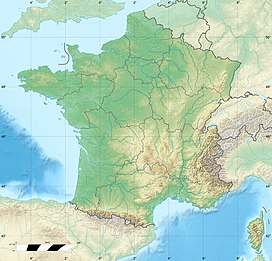Petit Dru
| Aiguille du Dru | |
|---|---|

The west and south-west faces of the Petit Dru, with visible grey rockfall scar (May, 2006)
|
|
| Highest point | |
| Elevation | 3,754 m (12,316 ft) |
| Listing | Great north faces of the Alps |
| Coordinates | 45°55′58″N 6°57′23″E / 45.93278°N 6.95639°ECoordinates: 45°55′58″N 6°57′23″E / 45.93278°N 6.95639°E |
| Geography | |
| Location | Haute-Savoie, France |
| Parent range | Graian Alps |
| Geology | |
| Mountain type | Granite |
| Climbing | |
| First ascent | 12 September 1878 by Clinton Thomas Dent, James Walker Hartley, Alexander Burgener and K. Maurer |
| Easiest route | AD |
The Aiguille du Dru (also the Dru or the Drus; French, Les Drus) is a mountain in the Mont Blanc massif in the French Alps. It is situated to the east of the village of Les Praz in the Chamonix valley. "Aiguille" means "needle" in French.
The mountain's highest summit is
Another, slightly lower sub-summit is:
The two summits are located on the west ridge of the Aiguille Verte (4,122 m) and are connected to each other by the Brèche du Dru (3,697 m). The north face of the Petit Dru is considered one of the six great north faces of the Alps.
The first ascent of the Grand Dru was by British alpinists Clinton Thomas Dent and James Walker Hartley, with guides Alexander Burgener and K. Maurer, who climbed it via the south-east face on 12 September 1878. Dent, in his description of the climb, wrote:
Those who follow us, and I think there will be many, will perhaps be glad of a few hints about this peak. Taken together, it affords the most continuously interesting rock climb with which I am acquainted. There is no wearisome tramp over moraine, no great extent of snow fields to traverse. Sleeping out as we did, it would be possible to ascend and return to Chamonix in about 16 to 18 hrs. But the mountain is never safe when snow is on the rocks, and at such times stones fall freely down the couloir leading up from the head of the glacier. The best time for the expedition would be, in ordinary seasons, in the month of August. The rocks are sound and are peculiarly unlike those of other mountains. From the moment the glacier is left, hard climbing begins, and the hands as well as the feet are continuously employed. The difficulties are therefore enormously increased if the rocks be glazed or cold; and in bad weather the crags of the Dru would be as pretty a place for an accident as can well be imagined.
The Petit Dru was climbed in the following year, on 29 August 1879, by J. E. Charlet-Straton, P. Payot and F. Follignet via the south face and the south-west ridge. The first traverse of both summits of the Drus was by E. Fontaine and J. Ravanel on 23 August 1901. The first winter traverse of the Drus was by Armand Charlet and Camille Devouassoux on 25 February 1938.
...
Wikipedia

